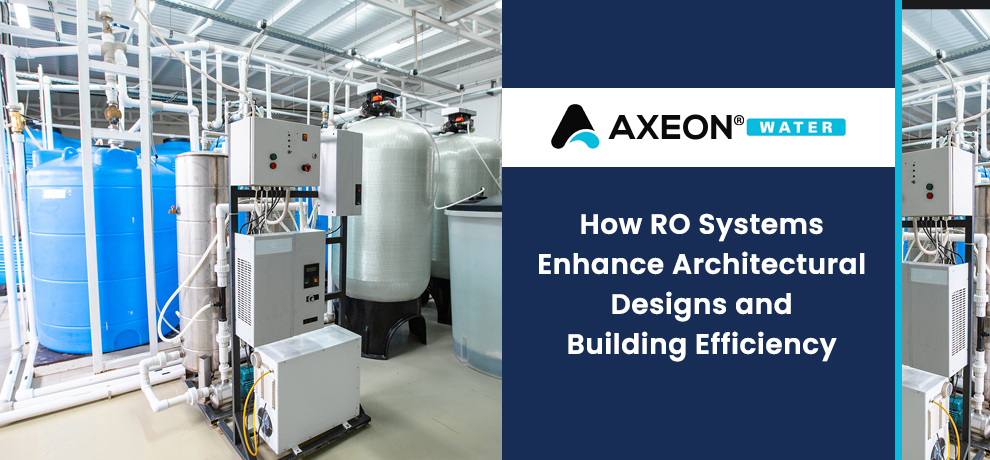Technical Articles

Reverse Osmosis (RO) systems are revolutionizing modern architecture by seamlessly integrating advanced water treatment technologies into sustainable building designs. These systems serve as a cornerstone for achieving energy-efficient buildings, reducing carbon footprints, and enhancing occupant comfort. By ensuring a consistent supply of high-quality water, RO systems contribute to the operational efficiency of residential, commercial, and industrial spaces.
Incorporating RO systems into architectural designs aligns with the growing emphasis on sustainable development and compliance with green building standards. Their compact and modular configurations allow for space-saving installations, making them ideal for diverse building types. Furthermore, these systems support innovative design strategies such as rainwater harvesting synergy and gray water recycling integration, which are essential for reducing water consumption and promoting a greener future.
The Intersection of RO Systems and Architecture
Reverse Osmosis (RO) systems have become integral to sustainable architecture, aligning seamlessly with the principles of energy-efficient design and creating a sustainable environment. These systems play a pivotal role in reducing water consumption while enhancing the overall functionality of modern buildings. By incorporating advanced water treatment technologies, architects can address critical challenges like resource conservation and operational efficiency.
Water-efficient infrastructure is a cornerstone of sustainable building practices. RO systems support these efforts by enabling gray water recycling integration and rainwater harvesting synergy, which significantly reduce the dependence on freshwater sources. This not only minimizes environmental impact but also promotes long-term cost savings for building owners.
RO systems contribute to sustainable design principles by offering modular configurations that adapt to diverse architectural needs. Their compact designs ensure seamless aesthetic integration into various building types, preserving architectural integrity while maximizing utility. These systems also help architects meet stringent green building standards, including LEED certification compliance.
By using RO systems, architects can create innovative spaces that balance functionality, sustainability, and occupant well-being. This harmonious blend of technology and design underscores the importance of integrating RO systems into architectural projects to achieve a greener future and enhanced energy performance.
Enhancing Building Efficiency with RO Systems.
Reverse Osmosis (RO) systems are pivotal in advancing building efficiency by addressing both energy conservation and operational cost reduction. These systems optimize thermal performance and reduce reliance on fossil fuels, contributing to a sustainable future. By utilizing energy-efficient filtration systems, RO technology minimizes energy wastage while ensuring a consistent supply of high-quality water.
One of the standout features of RO systems is their modular design, which enables space-saving RO units that seamlessly integrate into architectural layouts. This aesthetic system integration allows architects to preserve the visual harmony of building designs while incorporating cutting-edge technology. Additionally, RO systems help achieve compliance with LEED certification standards, a hallmark of sustainable building practices.
The operational benefits extend beyond energy savings; RO systems significantly lower operational costs by reducing water consumption and maintenance requirements. Their adaptability makes them suitable for various building types, from residential complexes to large commercial facilities. Furthermore, their role in supporting rainwater harvesting synergy and graywater recycling integration enhances resource efficiency, ensuring minimal environmental impact.
By integrating RO systems into architectural projects, designers can create buildings that prioritize sustainability, cost-effectiveness, and occupant well-being. These systems exemplify how advanced technologies can transform traditional infrastructure into models of efficiency and environmental stewardship.
Key Features of AXEON’s RO Systems for Architectural Applications
AXEON’s Reverse Osmosis (RO) systems are engineered to elevate architectural designs while meeting the demands of sustainable building practices. These systems feature high-rejection membranes that ensure superior water purification with low energy consumption, reducing operational costs and environmental impact. By utilizing renewable resources and adhering to green building standards, AXEON’s RO systems align perfectly with the principles of sustainable architecture.
The compact designs of AXEON’s RO systems minimize dimensional footprints, making them ideal for integration into diverse building types, including residential spaces, commercial facilities, and industrial applications. Their modular configurations allow architects to optimize space utilization without compromising functionality or aesthetic appeal. This adaptability supports space-saving RO units and seamless aesthetic system integration, ensuring harmony between technology and design.
AXEON offers extensive customization options to cater to specific project requirements. From ultrapure water systems for high-tech industries to brackish water systems for challenging environments, AXEON delivers tailored solutions that enhance operational efficiency and architectural flexibility. The inclusion of advanced monitoring features ensures optimal performance, while pre-engineered designs simplify installation and maintenance.
With over three decades of expertise, AXEON continues to lead the way in providing innovative RO technologies that contribute to a sustainable environment and a greener future for architectural projects.
Architectural Design Benefits
Integrating Reverse Osmosis (RO) systems into architectural designs offers significant advantages, enhancing both building functionality and sustainability. By improving indoor air quality and ensuring a contaminant-free water supply, these systems contribute to occupant comfort and promote a wellness-focused architecture. The use of RO systems aligns with modern architectural goals, where creating healthier indoor environments is paramount.
RO systems also support passive design strategies, which aim to reduce dependency on external water sources. For instance, by incorporating rainwater harvesting synergy and graywater recycling integration, architects can design buildings that conserve water while maintaining operational efficiency. These strategies not only optimize resource use but also contribute to achieving compliance with green building standards.
RO systems integrate seamlessly with smart building technologies, enabling automated water management and real-time monitoring. This ensures efficient system performance while minimizing energy waste. The adaptability of RO systems makes them suitable for diverse architectural applications, from residential complexes to large commercial facilities.
In response to the Question like, “What are the passive design strategies for energy-efficient buildings?”, passive strategies include leveraging natural resources, such as sunlight and rainwater, alongside advanced technologies like RO systems to reduce energy consumption and enhance the building’s overall efficiency. This combination fosters sustainable development and a greener future.
Conclusion
Reverse Osmosis (RO) systems have emerged as transformative solutions in the realm of architectural design and building efficiency. By integrating advanced water treatment technologies, these systems enhance energy conservation, reduce operational costs, and support sustainable building practices. Their modular and compact designs ensure seamless aesthetic integration while meeting stringent green building standards, making them indispensable for modern architecture.
AXEON Water Technologies leads the industry with its innovative RO systems, offering customizable solutions tailored to diverse architectural needs. With over 30 years of expertise, AXEON continues to drive advancements in sustainable design and building efficiency.
Discover AXEON’s range of cutting-edge RO solutions and take the first step toward creating sustainable, efficient, and future-ready architectural designs.
THE RIGHT SOLUTION FOR YOU
Contact us today for more information about our products and services.
CONTACT US
